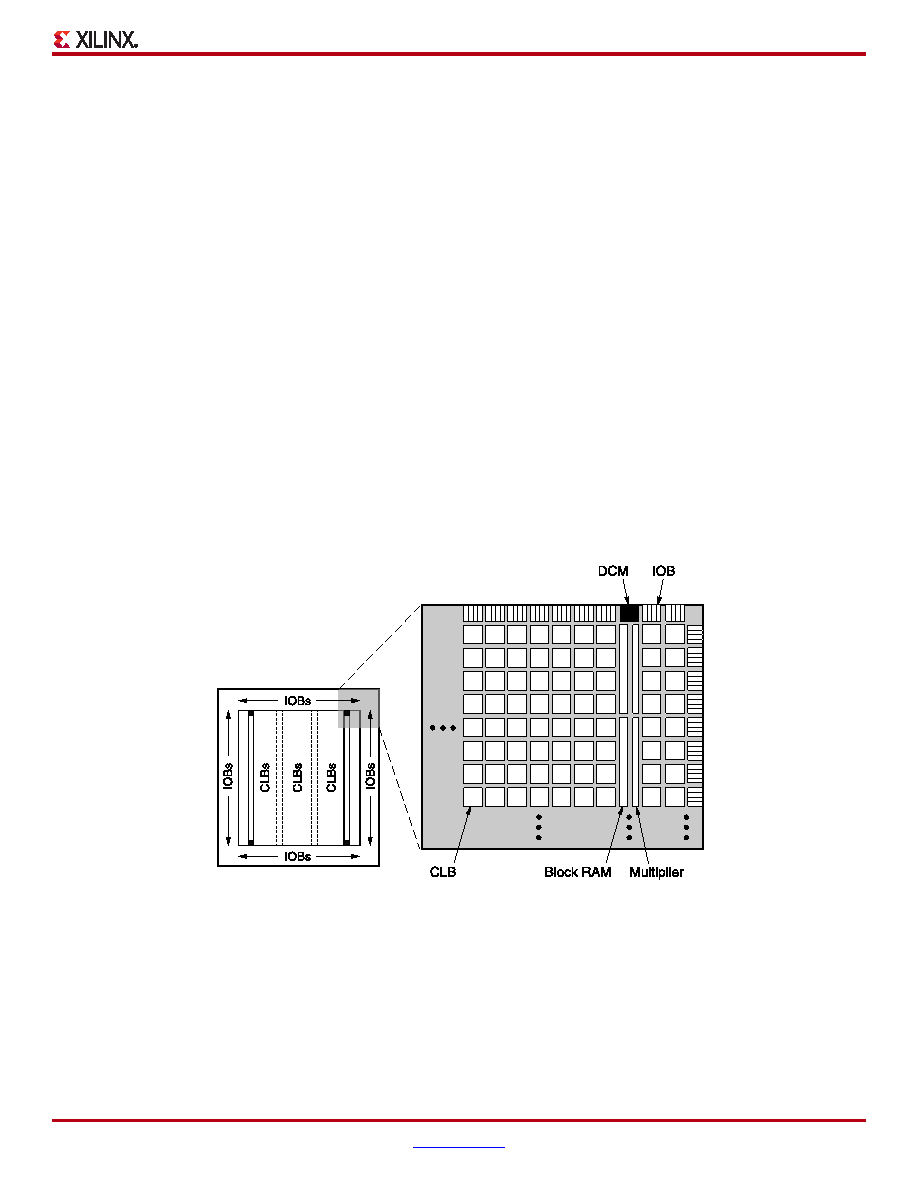- 您現(xiàn)在的位置:買賣IC網(wǎng) > PDF目錄4274 > XC3S1000-5FTG256C (Xilinx Inc)SPARTAN-3A FPGA 1M 256-FTBGA PDF資料下載
參數(shù)資料
| 型號: | XC3S1000-5FTG256C |
| 廠商: | Xilinx Inc |
| 文件頁數(shù): | 196/272頁 |
| 文件大小: | 0K |
| 描述: | SPARTAN-3A FPGA 1M 256-FTBGA |
| 產(chǎn)品培訓(xùn)模塊: | Extended Spartan 3A FPGA Family |
| 標(biāo)準(zhǔn)包裝: | 90 |
| 系列: | Spartan®-3 |
| LAB/CLB數(shù): | 1920 |
| 邏輯元件/單元數(shù): | 17280 |
| RAM 位總計: | 442368 |
| 輸入/輸出數(shù): | 173 |
| 門數(shù): | 1000000 |
| 電源電壓: | 1.14 V ~ 1.26 V |
| 安裝類型: | 表面貼裝 |
| 工作溫度: | 0°C ~ 85°C |
| 封裝/外殼: | 256-LBGA |
| 供應(yīng)商設(shè)備封裝: | 256-FTBGA |
| 配用: | 122-1502-ND - KIT STARTER SPARTAN-3 PCI-E |
第1頁第2頁第3頁第4頁第5頁第6頁第7頁第8頁第9頁第10頁第11頁第12頁第13頁第14頁第15頁第16頁第17頁第18頁第19頁第20頁第21頁第22頁第23頁第24頁第25頁第26頁第27頁第28頁第29頁第30頁第31頁第32頁第33頁第34頁第35頁第36頁第37頁第38頁第39頁第40頁第41頁第42頁第43頁第44頁第45頁第46頁第47頁第48頁第49頁第50頁第51頁第52頁第53頁第54頁第55頁第56頁第57頁第58頁第59頁第60頁第61頁第62頁第63頁第64頁第65頁第66頁第67頁第68頁第69頁第70頁第71頁第72頁第73頁第74頁第75頁第76頁第77頁第78頁第79頁第80頁第81頁第82頁第83頁第84頁第85頁第86頁第87頁第88頁第89頁第90頁第91頁第92頁第93頁第94頁第95頁第96頁第97頁第98頁第99頁第100頁第101頁第102頁第103頁第104頁第105頁第106頁第107頁第108頁第109頁第110頁第111頁第112頁第113頁第114頁第115頁第116頁第117頁第118頁第119頁第120頁第121頁第122頁第123頁第124頁第125頁第126頁第127頁第128頁第129頁第130頁第131頁第132頁第133頁第134頁第135頁第136頁第137頁第138頁第139頁第140頁第141頁第142頁第143頁第144頁第145頁第146頁第147頁第148頁第149頁第150頁第151頁第152頁第153頁第154頁第155頁第156頁第157頁第158頁第159頁第160頁第161頁第162頁第163頁第164頁第165頁第166頁第167頁第168頁第169頁第170頁第171頁第172頁第173頁第174頁第175頁第176頁第177頁第178頁第179頁第180頁第181頁第182頁第183頁第184頁第185頁第186頁第187頁第188頁第189頁第190頁第191頁第192頁第193頁第194頁第195頁當(dāng)前第196頁第197頁第198頁第199頁第200頁第201頁第202頁第203頁第204頁第205頁第206頁第207頁第208頁第209頁第210頁第211頁第212頁第213頁第214頁第215頁第216頁第217頁第218頁第219頁第220頁第221頁第222頁第223頁第224頁第225頁第226頁第227頁第228頁第229頁第230頁第231頁第232頁第233頁第234頁第235頁第236頁第237頁第238頁第239頁第240頁第241頁第242頁第243頁第244頁第245頁第246頁第247頁第248頁第249頁第250頁第251頁第252頁第253頁第254頁第255頁第256頁第257頁第258頁第259頁第260頁第261頁第262頁第263頁第264頁第265頁第266頁第267頁第268頁第269頁第270頁第271頁第272頁

Spartan-3 FPGA Family: Introduction and Ordering Information
DS099 (v3.1) June 27, 2013
Product Specification
3
Architectural Overview
The Spartan-3 family architecture consists of five fundamental programmable functional elements:
Configurable Logic Blocks (CLBs) contain RAM-based Look-Up Tables (LUTs) to implement logic and storage
elements that can be used as flip-flops or latches. CLBs can be programmed to perform a wide variety of logical
functions as well as to store data.
Input/Output Blocks (IOBs) control the flow of data between the I/O pins and the internal logic of the device. Each IOB
supports bidirectional data flow plus 3-state operation. Twenty-six different signal standards, including eight
high-performance differential standards, are available as shown in Table 2. Double Data-Rate (DDR) registers are
included. The Digitally Controlled Impedance (DCI) feature provides automatic on-chip terminations, simplifying board
designs.
Block RAM provides data storage in the form of 18-Kbit dual-port blocks.
Multiplier blocks accept two 18-bit binary numbers as inputs and calculate the product.
Digital Clock Manager (DCM) blocks provide self-calibrating, fully digital solutions for distributing, delaying, multiplying,
dividing, and phase shifting clock signals.
These elements are organized as shown in Figure 1. A ring of IOBs surrounds a regular array of CLBs. The XC3S50 has a
single column of block RAM embedded in the array. Those devices ranging from the XC3S200 to the XC3S2000 have two
columns of block RAM. The XC3S4000 and XC3S5000 devices have four RAM columns. Each column is made up of several
18-Kbit RAM blocks; each block is associated with a dedicated multiplier. The DCMs are positioned at the ends of the outer
block RAM columns.
The Spartan-3 family features a rich network of traces and switches that interconnect all five functional elements,
transmitting signals among them. Each functional element has an associated switch matrix that permits multiple connections
to the routing.
Configuration
Spartan-3 FPGAs are programmed by loading configuration data into robust reprogrammable static CMOS configuration
latches (CCLs) that collectively control all functional elements and routing resources. Before powering on the FPGA,
configuration data is stored externally in a PROM or some other nonvolatile medium either on or off the board. After applying
X-Ref Target - Figure 1
Figure 1: Spartan-3 Family Architecture
DS099-1_01_032703
Notes:
1.
The two additional block RAM columns of the XC3S4000 and XC3S5000 devices
are shown with dashed lines. The XC3S50 has only the block RAM column on the
far left.
相關(guān)PDF資料 |
PDF描述 |
|---|---|
| XC2V40-4FG256I | IC FPGA VIRTEX-II 256FGBGA |
| XC2V40-5FGG256C | IC FPGA VIRTEX-II 40K 256-FBGA |
| XC2V40-4FGG256I | IC FPGA VIRTEX-II 40K 256-FBGA |
| 3341-32BULK | CONN JACKSOCKET M2.5/4-40 0.50" |
| DB53750-2 | DSUB DB INTERFACIAL SEAL |
相關(guān)代理商/技術(shù)參數(shù) |
參數(shù)描述 |
|---|---|
| XC3S1000-5PQ208C | 制造商:XILINX 制造商全稱:XILINX 功能描述:Spartan-3 FPGA |
| XC3S1000-5PQ208I | 制造商:XILINX 制造商全稱:XILINX 功能描述:Spartan-3 FPGA |
| XC3S1000-5PQG208C | 制造商:XILINX 制造商全稱:XILINX 功能描述:Spartan-3 FPGA Family: Complete Data Sheet |
| XC3S1000-5PQG208I | 制造商:XILINX 制造商全稱:XILINX 功能描述:Spartan-3 FPGA Family: Complete Data Sheet |
| XC3S1000-5TQ144C | 制造商:XILINX 制造商全稱:XILINX 功能描述:Spartan-3 FPGA |
發(fā)布緊急采購,3分鐘左右您將得到回復(fù)。